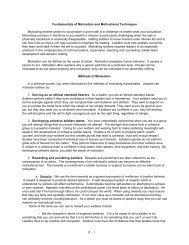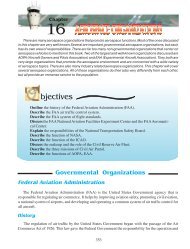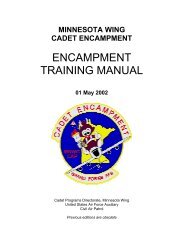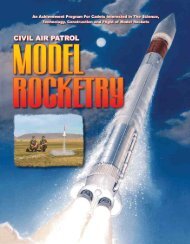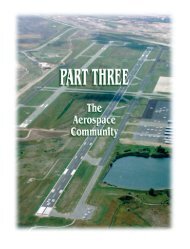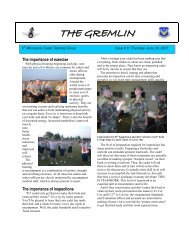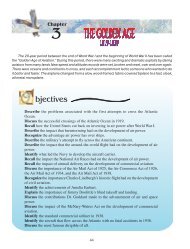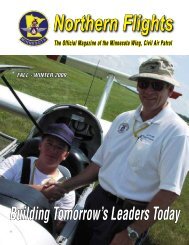Chemical Propulsion - Civil Air Patrol
Chemical Propulsion - Civil Air Patrol
Chemical Propulsion - Civil Air Patrol
You also want an ePaper? Increase the reach of your titles
YUMPU automatically turns print PDFs into web optimized ePapers that Google loves.
PROPULSION SYSTEMSWith a few exceptions, propulsion systems for rockets and spacecraft today use chemical propellants.These propellants can be solid, semisolid, gelled or liquid, depending on whether they are pressurized.However, they are most often in solid or liquid form.How rapidly a solid propellant burns depends on how much of its surface is exposed to burning at anyone moment. Of course, this depends on the design or molding of the solid-propellant charge within itscontainer. It is relatively easy to throttle or change the thrust of a liquid-propellant rocket, but it is very difficultto control the thrust of a solid-propellant type. Why and how these conditions exist will be examinedin this chapter. We will look at special factors and conditions influencing the use of liquid propellants andexamine rocket engine (or motor) design and function.bjectivesExplain oxidation.State the difference between an oxidizer and a reducer.Define cryogenics, hydrocarbons and a self-reacting compound.State the difference between a propellant, a bipropellant and a monopropellant.List the four qualities of a good propellant.Explain why a rocket propellant does not need air.Explain the difference between an air-breathing engine and a rocket engine.Define hypergolic propellants, mass flow and low explosives.Identify a way to get more force from a load of propellant.Describe the purpose of the rocket engine.Describe the function of the rocket motor throat and nozzle.Compare the features of the liquid and solid-propellant chemical systems.Name two systems that use solid propellants.Describe the solid-propellant chemical system.Explain how the burning rate of solid propellants is controlled.State the purpose of a squib in a solid-propellant rocket.Describe a liquid-propellant engine system.Discuss the combustion chamber of a liquid-propellant system.Explain the function of the coupled valve in a combustion chamber.Explain the function of the injector in a liquid-propellant engine.Describe the hybrid propellant system.State the advantages of a hybrid propellant system.466
Chapter 22- <strong>Propulsion</strong> SystemsOxidation and CombustionCombustion is nothing more than very rapid oxidation, but what is oxidation? Oxidation is thecombination of oxygen with another substance. The time it takes for this combining process to takeplace determines whether the substance rusts or corrodes, burns as a fire or explodes violently.A chunk of rusting iron and the heat, pressure and light of a functioning rocket engine are doingthe same thing. It just takes one longer to become oxidized than it does the other. Another similaritybetween these two extremes of oxidation is that both require oxygen (oxidizer) and a substance to beoxidized. The substance to be oxidized is also known as the reducer. Thus, the iron in the example isthe reducer and the oxygen in the air touching the iron is the oxidizer. For the rocket, one chemicalcompound is the reducer, while the oxidizer is either another chemical compound or perhaps oxygenin pure form—liquid oxygen.Oxidizers and ReducersVarious combinations of oxidizerreducerscan produce an almost endlessvariety of oxidation reactions. When itcomes to rocketry, however, a few elementsoccurring in a wider variety ofcompounds (molecular bonding of twoor more elements) dominate the field.Oxidizers. The element oxygenexists in air as two molecules. To useit in its pure form as an oxidizer forrocket fuels (or reducers), it must bechilled until it becomes liquid. Thismeans that the oxygen must reach andbe kept at a temperature of -297 degreesF. The reason why this temperature (orlower) must be maintained is that theoxygen will boil (become gaseous) atany higher temperature. Temperaturesin this range come within a classificationknown as cryogenics.Cryogenics is an area of scienceconcerned with the production of lowtemperatures and the effect of such temperatureson matter. Thus, wherever you467
Chapter 22- <strong>Propulsion</strong> Systems500 pounds of oxidizer and 500 pounds of reducer, nor is it necessary to say that they are stored withinthe same container or in separate containers.Speaking of propellant storage, other terms are used to describe the storage arrangement of apropellant’s oxidizer and reducer. If the oxidizer is stored in one container and the fuel (reducer)in another, the term bipropellant is used. Bipropellants are not mixed until they reach the engine’scombustion chamber. Back to the Saturn V: the first-stage bipropellant was oxygen and kerosene; thesecond- and third-stage bipropellants were oxygen and hydrogen. For all three stages, the propellantswere pumped into the combustion chamber of the engine where ignition and burning took place. Themajority of liquid-propellant rockets use the bipropellant arrangement.In some cases, the liquid oxidizer and fuel can exist together in the same storage tank. Here thepropellant also is pumped into the combustion chamber of the rocket engine and ignited. However, the factthat separate storage tanks are not necessary qualifies the propellant to be called a monopropellant.<strong>Chemical</strong>ly, when an oxidizer and a reducer occur in a mixture, they are considered to be two separateingredients. There is such a thing as a self-reacting compound. In such a compound, one moleculecontains atoms of both oxidizer and reducer and, upon ignition, reacts with itself, yielding energy asit breaks down or decomposes.Combustion for <strong>Propulsion</strong>The final objective in considering any combination of chemicals as a propellant is how much forcecan be obtained as the mixture oxidizes. However, there are other considerations that are recognized asthe qualities of a good propellant: (1) the propellant must contain oxidizer and fuel, (2) it must ignitecorrectly every time, (3) it must produce energy in the form of force, and (4) the force produced mustbe controllable. Let’s consider these four qualities individually.Need for Packaged Oxidizers. Aside from propulsion in space, where no free oxygen is available,there is another reason for putting oxidizer in a concentrated package. An oxidizer-reducer mixturewill burn forcibly in a confined or semi-confined space in which an air-breathing fire would besmothered.People knew this fact for centuries without knowing the reason why and used it long before airbreathingengines were everimagined. Old-fashionedgunpowder or “black powder”needs no air to burnits carbon and sulfur fuelingredients because it hasan oxidizer built into a thirdingredient, potassium nitrateor saltpeter.The ability of this mixtureto propel a rocket orhurl a cannonball out of anAn Example of Rocket Thrust469
iron tube was known and employed in warfare centuries before Lavoisier discovered oxygen and theprinciple of oxidation in the eighteenth century. To this day, all chemical rocket propellants, all gunmunitions, and all chemical explosives contain an oxidizer, burn in confinement and do their work bybursting out of confinement or rushing out of semi-confinement.Rushing out of semi-confinement describes rocket-propellant action. In a rocket-propellant mixture,the oxidizer outweighs the fuel something like five to three. Because the packaged oxidizer isexpensive and a rocket propellant needs so much of it, the air-breathing engine is much less expensiveto operate than any type of rocket engine. Still, the air-breathing engine cannot operate within both theatmosphere and space as does the rocket engine.Ignition Characteristics. How fast a mixture burns is not necessarily related to how easily it starts.What properties of a propellant should be considered? Since the starting time of the rocket engine isimportant to controlling it, the propellant must start every time in the same way.Another factor that must be considered is a choice between a continuous or restartable propellant.Some propellants can be started, but continue burning until all of the propellant is exhausted (a burnout).Others can be repeatedly started and stopped.Safety is also a very important factor. This does not mean the propellant can stand up to any kindof rough or careless handling without igniting, but it does mean that its safety requirements should beknown and feasible. Some propellants are ignitable the old-fashioned way with a match, flame or hotwire. Others require greater and more concentrated heat. Some require an explosive shock. Some arehypergolic; that is, under normal temperatures, the oxidizer and reducer burst into flame the instantthey meet. The main safety requirement in thiscase is to keep the ingredients separated.Energy for Force. Not light and not heat,but force is what we’re looking for from apropellant’s release of energy—the sheer momentumof moving molecules. What is desiredis mass flow of combustion exhaust, but thismass can be no greater or less than the mass ofingredients before combustion.Although a designer might wish to lightenthe propellant load aboard a vehicle, there mustbe a certain amount of propellant on board toGas Changes to a Propellantproduce the needed thrust. This load aloneconstitutes most of the initial weight of a launch vehicle. The only way to get more force per load is toincrease the velocity of the mass flow—that is, to get more “speed” per molecule. Therefore, it is betternot to increase mass flow by means of heavier molecules that are too sluggish. The ideal exhaust gasconsists of plenty of lightweight molecules, which excel in energy and velocity.Controllable Force. When a propellant burns, the speed of the combustion should not be excessive.Fast, but not too fast, is the rule of thumb. How is this combustion process regulated? If a liquidpropellant is used, the task of controlling the force is basically easy. All that is necessary is to governthe amount of propellant reaching the combustion chamber. This is similar to governing the amountof fuel/air mixture reaching the cylinders of an automobile engine through actions of the throttle and470
Chapter 22- <strong>Propulsion</strong> Systemscarburetor.Controlling the force of a solid propellant is slightly more difficult. There are ways of controllingthe force desired from a solid-propellant rocket. Basically, a solid propellant is selected (or developed)according to its ability to produce force without causing a massive, destructive explosion.In fact, solid propellants sometimes are called “low explosives.” Modern solid propellants areconsiderably more energetic than the black-powder-type propellant used with very early rockets. Yet,they have the black powder’s property of burning so that each particle ignites its neighbor particle andthe burning continues as a swiftly spreading reaction.Pressure and Mass FlowAdding pressure to a medium will increase its molecular activity and consequently, its temperature.Increase the temperature of a medium and its molecular activity and pressure will be increased— thisis particularly true with a gaseous medium that is enclosed by a container. Thus, the purpose of therocket motor or engine is to provide a container in which the temperature (of the oxidizing propellant)increases the pressure of the gaseous portion of the medium.If some means were not provided to relieve the constantly building pressure of a burning propellant,the container would burst. Among the functions performed by the nozzle throat and nozzle of the rocketmotor are to provide an exit for the burned propellant mass, reduce the pressure within the combustionarea and direct the flow of the mass involved.We can imagine what happens within the “business end” of a rocket on a molecular scale. Thediagram below shows what happens to a single molecule that has been energized by combustion andpressure. Loaded with this energy, the molecule zips about at location A. It beats madly at its prisonwalls, creating pressure. However, there is a way out of its prison, and the molecule will get there alongwith a crowd of its highly active fellow molecules. We see it again at location B and again at locationC. Note that its path continues to be erratic, but less and less so—more zig and less zag, one might say.Finally, it escapes.This wandering molecule would seem to begoing through a great deal of wasted motion andtaking much too long to make its exit. Actually, itis making excellent progress. The whole journey isaccomplished in a fraction of a second.More significantly, at each stage of the journeyConcept of a molecule’s path to exit a rocket engine.it is traveling faster than before and in the right direction.Furthermore, the greater the pressure in thechamber, the greater the velocity through the nozzle. It is its speed out the nozzle that counts most.The net result, acceleration, is the essence of thrust. The mass of molecules is accelerating in respectto the motor, and the motor itself is moving. As long as combustion is going on inside and mass flowis passing out the nozzle, the motor adds velocity to velocity and accelerates.Today, chemical systems are the most often used means of propulsion, When a lot of thrust isneeded, rockets are usually propelled by a liquid fuel, such as kerosene and liquid oxygen (oxidizer).The propellants are mixed as they enter the combustion chamber to be ignited. A spark or small flame471
is used to start the ignition process. From then on, continuing combustion ignites the fuel and oxidizeras they enter the combustion chamber. The drawback to liquid chemical systems is that they requireexpensive plumbing, turbines, pumps, and engines.Solid PropellantsSolid Propellants andthe Solid-Propellant EngineThe chemical system may have a solid rather than a liquid propellant. The fuel and oxidizer of asolid propellant are mixed together from the start. The skyrocket is a good example of a solid propellant;all it takes is ignition of the mixture. The combustion chamber and the propellant container areone and the same. This means that the solid-propellant chemical system is simple, much less costlythan the liquid type and is very reliable. Today, solid propellants are used for our submarine-launchedballistic missiles, the Minuteman intercontinental ballistic missiles, the first three stages of the MXmissile and as boosters for the space shuttle system.Fuels used in solid propellants include asphalts, waxes, oils, plastics, metals, rubbers and resins. Theoxidizers for solid propellants come from two general sources: the organic (the source of nitrocelluloseand nitroglycerin) and the inorganic (the source of chemicals such as sodium nitrate and potassiumperchlorate).<strong>Chemical</strong> and Physical PropertiesA look at the contents of a typical double-base propellant tells much about the requirements of asolid propellant. Typical of today’s solid propellants are composites in which the fuel and oxidizer aretwo different compounds. Usually the oxidizer is crystalline in form (like salt or sugar) and is embeddedin the fuel base. Specific impulses of a double-base propellant and several composite propellantsare as follows:In a solid rocket motor (motor usually is associated with solid propellant whereas engine is associatedwith liquid propellants), the propellant substance is molded into its motor and casing as a single solidmass called a grain. The shape and consistency of the grain determine its burning properties.The polyurethane fuel base of the most common solid-fuel mixture is a type of synthetic rubber.It maintains about the same consistency as that of tire rubber. Various other rocket propellants havesimilar plastic consistencies. It is very important that this consistency be even and free from internalbubbles or surface cracks. Exposure of more burning surface than intended could result in the dangerof uncontrolled burning or an explosion. The casing into which the grain is molded must be tough and472
Chapter 22- <strong>Propulsion</strong> Systemsheat resistant. A lining material is used as an insulator, and the case itself is made of various materialssuch as special steels, titanium and fiberglass.Grain Design and Thrust ControlOnce a solid propellant is ignited, it is going to burn. It can’t be turned off and then restarted as isdone with liquid-propellant systems. Some solid propellants can be stopped from burning by dousingthem with water, but others cannot be stopped. So, how does one control the burning rate of a solidpropellant? How can the amount of thrust produced be controlled? The primary way of doing this is tomold the propellant into a shape that will provide the desired burning rate.The flame front (where actual oxidation is taking place) of a solid propellant always eats its wayinto the mass in a direction that is perpendicular to the surface. The flame eats its way into a mass at afixed rate depending on the contents of the propellant. For example, a typical double-base propellant’sburning rate is about 0.40 inch per second; a dense polyurethane composite burns at about 0.22 inchesper second. Since these rates do not change, the only way to control the amount of force (or thrust)generated is to control the surface area exposed to the burning process.The grain of a common skyrocket more than likelyis a solidly packed propellant, with a space for ignitionbetween the charge and the nozzle. Once ignited,this grain can burn only straightforward and the flamefront is limited to the surface diameter. Thus, the burnrate (whatever it is) does not change until burnout.Since the burn rate doesn’t change and the flame-frontGrain Designs for Solid Propellantsarea doesn’t change, the amount of thrust produced isconstant. When this type of situation exists, the grain design is neutral.What if a hole is bored the length of the grain, or charge, along its longitudinal axis? There will bean instantaneous spread of the flame-front along the entire surface of the hole. This, of course, providesa larger surface area of flame and greater force. As the grain continues to burn, more and more surfacearea is exposed so more and more thrust is produced. This is called a progressive burn rate.Suppose a considerable amount of thrust is needed, but the designers want the thrust to be neutral.The design shown above might be used. Ignition produces a large amount of thrust very quickly, but thedesign keeps the surface area constant. Remember, the flame eats its way into the mass perpendicularto the surface.The third design is one for a regressive rate. With this design, the most thrust is produced shortlyafter ignition, and it diminishes thereafter. A similar approach is used for the space shuttle’s solid rocketboosters. The most thrust is produced upon ignition and during the first 55 seconds of the 2-minuteburn. The grain of these boosters is shaped so that it then reduces thrust by approximately one-thirduntil burnout.There are other ways of controlling the amount of thrust or burn rate of a grain. The grain can bemade up of different propellant mixtures that have different burn rates. Another method of control is473
to paint certain surfaces of the propellant with a heat resistant compound, leaving the other surfaces toburn at their regular rate.Control of a solid rocket motor’s thrust depends primarily on the design and composition of thegrain, as indicated earlier. It is also possible to stop thrust in a solid propellant by injecting a high-pressureinert (or neutral) gas into the chamber. A grain stopped in this manner could be restarted. However,such arrangements have not proven worth the effort. So, once the grain is ignited, it continues to burnand produce the amount of thrust for which it was designed. Control of the direction of thrust is anothermatter. Thrust directional control for the solid-propellant rocket can be obtained from the same typedevices used with liquid-propellant rockets.IgnitersSolid propellants are ignited by a composition that both heats the grain to ignition temperature andincreases the pressure in the combustion chamber until propellant reaction is assured. The heat producedby an electrical wire could ignite a few of the older solid-propellant mixtures. Today, this typeof ignition device is found in model-rocket launching devices, but the real rockets use devices like thesquib. The squib consists of an enclosure filled with a combustible powder that is ignited electrically.The flame of the burning squib, in turn, ignites the grain.Two igniter compositions frequently used are common gunpowder and a metal-oxidizer mixturesuch as magnesium and potassium perchlorate. Each of these has advantages over the other. Each alsohas certain disadvantages. Gunpowder is inexpensive, but it tends to absorb moisture, which can adverselyaffect its performance. Metal-oxidizer igniters are generally more efficient and ignition delaysare shorter. However, they are more hazardous to handle than black-powder igniters. If magnesiumis used in igniter composition, surface oxidation is likely to occur. Once oxidized, the igniter doesn’twork very well.A critical part of an igniter is the case that contains the composition. Manufacturers of ignitershave a variety of materials to choose from, ranging from paper to metal. The strength of the containermust be sufficient for demands made upon it. For example, rapid ignition requires the container to bestrong enough to remain intact, until all the composition has ignited. However, the container must bedesigned so that no part of it is large enough to block the exhaust nozzle. Such blocking could causeextremely high pressures and damage the engine. The location of the igniter depends upon the designof the grain.Liquid PropellantsLiquid Propellants andthe Liquid-Propellant EngineYou will remember that there are two general classifications of liquid propellants: bipropellant andmonopropellant. When the oxidizers and fuels are separated, we refer to the two as a bipropellant. Any474
Chapter 22- <strong>Propulsion</strong> Systemsrocket that uses a bipropellant has a liquid-bipropellant propulsion system. However, it is not necessaryfor all liquid propellants to have their oxidizers and fuels kept separate. When a liquid propellantcontains its oxidizer and fuel in one solution, it is called a monopropellant.Bipropellants have an advantage over monopropellants in that they are more stable and capable ofbetter performance. Bipropellants consist of two types: the nonhypergolic (nonself-igniting) and thehypergolic (self-igniting). Each of the two types of bipropellants has advantages and disadvantages.Malfunctioning of equipment and accidents involving a system using either type of bipropellant canbe disastrous.An ignition delay, even a briefone, results in a sufficient accumulationof nonhypergolic fuel andoxidizers in the combustion chamberto cause a damaging explosion.The components of a hypergolicpropellant catch fire when broughtinto contact one with the other.The design of a liquid-monopropellantsystem is much simplerthan the design of a bipropellantsystem. A monopropellant systemrequires only half the storage,pumping and controlling equipmentrequired by a bipropellantsystem. It doesn’t require meteringto keep the fuel and oxidizer inComparison of Bipropellant and Monopropellant <strong>Propulsion</strong> Systemscorrect proportion.The drawback of a monopropellantis its sensitivity to temperature and shock. This sensitivity results in instability and restricts itshandling. Generally, monopropellants also require more heat for ignition and react more slowly thanbipropellants. These factors mean that monopropellants require larger combustion chambers.Just as there are two general types of bipropellants, there are two general types of monopropellants:those that obtain energy by combustion and those that obtain energy by dissociation reaction(decomposition). A catalyst initiates the dissociation reaction.To ignite a liquid propellant, it is necessary to raise the temperature of a small part of the mixture toits ignition point. The flame will then spread throughout the total mixture. Mixtures that contain liquidoxygen have a high reaction rate, so these mixtures are easy to ignite. For example, an ordinary sparkplug can be used to ignite a flow of oxygen and alcohol.One method of igniting a liquid-propellant mixture is to inject a limited amount of hypergolic fuelinto the combustion chamber along with the oxidizer just before the main fuel flow starts. Anothermethod uses a pyrotechnic fired electrically from an external circuit. If repeated ignitions are requiredduring flight, a small precombustion chamber makes the ignition of a small amount of the propellantpossible by means of a spark plug. The flow into the main chamber is delayed until the propellant in the475
precombustion chamber is ignited. The flame from the precombustion chamber is then used to ignitethe mixture in the main chamber.The Liquid-Propellant EngineThe essential units of a liquid-propellant system include propellant tanks, a combustion chamberand a means of forcing propellants from the tanks through control valves to the combustion chamber.The simplest liquid-propellant engine system transfers oxidizer and fuel from tanks to the combustionchamber by pressurizing the tanks with an inert gas such as nitrogen. More complex systems employturbopumps to transfer propellants to thecombustion chamber.The nature of the propellant determines,to a great degree, the structuraldesign of the engine or propulsion system.Quite often, the use that will be made ofthe liquid-propellant engine determinesboth the nature of the engine’s design andthe type of its liquid propellant.There are many kinds of liquid fuelsand a number of liquid oxidizers that areavailable for use in liquid propellants. Itis possible for a single oxidizer to reactwith many different fuels. Also, a singlefuel can react with a number of differentoxidizers; for example, kerosene (a fuel)reacts with liquid oxygen, hydrogen peroxideor nitric acid. For this reason, manycombinations of fuels and oxidizers arepossible.The basis for choosing a certainfuel-oxidizer combination might includeeconomy, safety, ease of handling, andpurpose. However, the fundamental factorunderlying the choice of a propellantMajor Components of a Liquid-Bipropellant <strong>Propulsion</strong> Systemcombination is generally the performance of such a combination.Combustion ChamberThe combustion chamber is the “heart” of the liquid-propellant engine. Within this chamber, severalphases of the combustion process take place. These phases include: (1) atomizing, (2) mixing, (3)preheating to ignition temperature, and (4) the reaction of the propellant.476
Chapter 22- <strong>Propulsion</strong> SystemsA combustion chamber may be cooled or uncooled. Combustion temperatures of propellants used inuncooled combustion chambers frequently are under 1,000° C. When it is desired to construct uncooledcombustion chambers that will withstand relatively high temperatures over a comparatively long periodof time, they are given an interior ceramic or carbon coating.There are several methods of cooling a combustion chamber, but the most commonly used methodis by regenerative cooling. In this method, fuel or oxidizer is circulated within small passagewaysbetween the inner and outer walls of the combustion chamber, throat and nozzle. As the propellantflows through the passageways, it absorbs heat, thereby cooling the combustion chamber. The absorbedheat also adds energy to the fuel or oxidizer before it enters the injector and increases the velocity ofinjection into the combustion chamber.ValvesA propellant system’s tanks and plumbing must be constructed of materials that are not adverselyaffected by the nature of the fuel and oxidizer the system uses. The nature of the fluids a system usesalso determines the kinds of materials used to make valves. The scope of both the operating temperaturesand operating conditions to which they are subject makes it necessary to use high-precision techniquesin valve manufacturing.Valves used in propellant systems range in type and size according to their specific functions.Comparatively large valves, for example, are used to control the high flow of fuel and oxidizer. A coupledvalve, consisting of two propellant valves opened by a single piston, operates through a crosshead,causing fuel and oxidizer to enter the combustion chamber at the same time.InjectorThe function of the injector of a liquid-propellant rocket engine is similar to that of the carburetorused with some automobile engines. Just as a carburetor atomizes (reduces to small particles) and mixesfuel and air, preparing the mixture for combustion,the injector atomizes and mixes fuel and oxidizer.The type of injector used depends upon the typeof propellant. Lightness, simplicity and low cost arefactors that need to be considered by manufacturersof rocket-engine injectors. However, just as is thecase with valves and other rocket-engine components,precision and exactness of construction of theinjector are very important.Two types of injectors are in common use. Thedifference between them is the difference betweenthe methods each uses to mix fuel and oxidizer.In the swirl-jet type, each propellant is introducedinto the chamber in an inverted-cone-shaped spray,Operating Principle of the Impinging-Jet-Type Injector finely atomized and sufficiently diffused for adequate477
mixing with the adjacent spray. In the impinging-jet type, the fuel and oxidizer enter the combustionchamber directly through openings arranged in such a way that the streams of fuel and oxidizer strikeeach other (impinge on one another). Their collision causes the required atomization and mixing.Improved injection systems have contributed to the development of throttleable (variable control)liquid-propellant engines. One such system mixes, in a specially designed manifold, gas under highpressure with liquid fuel before it is injected into the combustion chamber. Depending on the ratioof gas to liquid fuel, the engine may be throttled from a low to a full thrust, and may be stopped andstarted in flight.Hybrid PropellantsHybrid propellant systems use both liquid propellants and solid propellants in combination withinthe same engine. Thus, rockets that use this type of propellant system are called hybrid rockets. Usually,solid material is used as the fuel, and a liquid is used as the oxidizer. However, there are systems thatuse liquid fuels and solid oxidizers. When solid fuel is used, it is packed into the rocket engine as aninert material without its oxidizer. The liquid oxidizer is stored in a separate tank. To create combustionand generate thrust, the oxidizer is fed into the solid-fuel combustion chamber at a desired rate. Inone such system, the solid fuel and the oxidizer do not come into actual contact. Instead, the heat ofignition vaporizes the oxidizer and the fuel. These gases, approaching each other from opposite directions,unite and burn just above the face of the fuel grain. The thrust produced by the hybrid rocket canthereby be increased or decreased simply by increasing or decreasing the flow of oxidizer over the fuelcharge. Thrust is stopped when the flow of oxidizer is closed off.The hybrid propellant system combines,in a single rocket, many of theadvantages of both liquid-propellantrockets and solid-propellant rockets. Ithas the flexibility, controllability andhigh performance of liquid rockets, plusthe simplicity, reliability and relativeeconomy of solid rockets. FlexibilityDiagram of a Hybrid Propellant Systemprobably gives the hybrid rocket itsbiggest operational advantage. It can bethrottled, like a liquid rocket, from zeroto full thrust, and it can be stopped and started in flight.The diagram above is a very simple diagram of how the parts of a hybrid propellant systemmight be arranged. In the system illustrated, the valve controls how much oxidizer is allowed to comein contact with the fuel. This amount, or rate of oxidizer to fuel, determines how much thrust the systemproduces. In this particular design, the grain has been molded for a progressive burn rate. To maintaina steady thrust could require less and less oxidizer as the process continues.478
Chapter 22- <strong>Propulsion</strong> SystemsAEROSPACE PROPULSION TECHNOLOGYSince the invention of the first heavier-than-air flying vehicle, designers, builders, pilots, war plannersand commercial airlines have sought aircraft capable of higher and higher speeds. The requirementsfor faster vehicles have changed significantly since the early years of flight and the technologies usedto achieve high speeds are undergoing significant advances.The <strong>Air</strong> Force Laboratory’s <strong>Propulsion</strong> Directorate has been the key national organization to developand demonstrate these technologies.Since 1917, the Directorateand its predecessor organizationshave been developing criticalpropulsion technologies, whichhave in turn, enabled revolutionaryadvances for the country’sarmed forces.Aerospace <strong>Propulsion</strong>Technologies DefinedWhat are Aerospace <strong>Propulsion</strong>Technologies? Simplyput – these are propulsion systemsthat utilize fuel and atmosphericoxygen for fuel combustionthroughout all or part of theirCurtis V2-3 as used in WWI aircraft (courtesy of the <strong>Air</strong> Force Museum)intended flight regime. Called air breathers, these propulsion systems are capable of at least Mach 5and are categorized as hypersonic. These engines can range from single propulsion systems with singleor dual mode combustion schemes up to multiple or combined cycle systems for multiple propulsioncycles with high speed turbines, scramjets, and rockets.This publication focuses on current and future efforts to realize true, high speed endo-atmosphericflight, and specifically covers our efforts to develop and demonstrate high speed air-breathing propulsionsystems. As the graph below indicates, enormous potential exists to expand the flight envelopeof high speed air-breathing propulsion.Hypersonic <strong>Air</strong>breathing <strong>Propulsion</strong> Requires Advances in the Current State-of-the-Art. Onlyby advancing the state-of-the-art in turbine engine, ramjet/scramjet, and rocket technologies can trueaerospace propulsion systems be realized.AFRL’s <strong>Propulsion</strong> Directorate leads the nation in the development of these critical technologies.Teaming with other government agencies and the propulsion industry at large, the Directoratehas ensured technology research and development programs that address all technical challenges ofaerospace propulsion systems.479
High Speed Enables aBroad Range of RevolutionaryCapabilities480An early V-8 liquid-cooled aircraft engine.There are several potential missionswhere high speed aerospace propulsioncould have significant payoff.These missions are illustrated below.Near Term – Expendable Systems– Supersonic, Long-Range CruiseMissiles. Small, supersonic turbineengines currently being developedcan power a long range (thousands ofmiles), supersonic cruise missile. Producedin modular form, this Mach 3-plus capable missile can be assembledto match the required combat capability.Such a missile would provide a 4 times speed increase over fielded systems with a commensurateincrease in range.Hypersonic, Hydrocarbon-Fueled Rocket Boosted Strike Missiles. Using higher speed airbreathingpropulsion such as a ramjet or scramjet coupled with solid rocket motor boost, hydrocarbonfueled air-breathers can achieve Mach 7+ at high altitudes. Such performance enables the capabilityto engage time critical targets with a responsetime much less than current capabilities. Thesehypersonic weapons could also have long rangesand a majority of targets can be engaged by launchaircraft outside an adversary’s national borders.The use of readily available and logistically supportablecarbon fuel increases the readiness andavailability of such systems. The kinetic energyavailable in such high speed systems make themideal for penetration of deeply buried hardenedtargets.Enable Space Lift. The technology developedfor scramjet-powered high speed missilesform the foundation of low cost space launchsystems for small payloads requiring short reactiontime to launch.Using hydrocarbon-fueled scramjets and solidThe radial engine brought reliability and great power-toweightpropulsion systems to aircraft of the 20th Century.rocket propulsion; these vehicles could be airlaunched and have the capability of inserting a1000 pound payload into low earth orbit (LEO).Mid- and Long-Term Reusable Systems.
How Do Aerospace <strong>Propulsion</strong> SystemsProvide Transformational Capabilities?The <strong>Air</strong>-Breathing Advantage. The advantage of air-breathing hypersonic propulsion systemsstem from the fact that they obtain oxygen for combustion from the earth’s atmosphere. Unlike purerocket-powered vehicles, the resultant vehicle does not have to carry the oxygen inside the vehicle.Higher <strong>Propulsion</strong> Efficiency (Isp). <strong>Propulsion</strong> efficiency, designated Isp, is defined as the ratio ofan engines thrust to the weight of fuel burned in one second. The higher the number, the more efficientthe propulsion system. High bypass turbofan engines have the highest specific impulse that are capableof only modest velocities. High speed turbojets can generate appreciable velocities and the chart curvesindicate the practical limits of pure turbo propulsion. Ramjets and scramjets take the Mach range outmuch further and using hydrogen as a fuel can theoretically accelerate a vehicle to Mach 25.Smaller Mass Fractions. With higher propulsive efficiency, more of the flight vehicle can bededicated to performing mission requirements. This is typically defined as the vehicle systems massfractions. As an example, a typical unmanned rocket powered launch vehicle has a mass fraction ofabout 10%. That means 90% of the vehicles total launch weight is made up of propellant. If scramjetswere used as the primary propulsive system for a space launch vehicle, up to 28% of the vehicle weightcould be dedicated to mission requirements, or over twice that of a conventional all-rocket poweredlaunch vehicle.<strong>Air</strong>plane-Like Design andFlight Characteristics. Usingair-breathing propulsion forspace access systems allowsvehicles to be designed thatoperate like airplanes while inthe atmosphere. This advantageallows for greater margin ofsafety in space launch vehicleswhereby the mission can be terminatedat practically any pointof the flight profile (unlike a purerocket, which has no mission terminationmargin.) Vehicles canbe made smaller and lighter fora given payload. This reducesthe amount and cost of supportinfrastructure necessary to sustainflight operations.America’s First Operational Jet Fighter, the Bell P-59 <strong>Air</strong>acomet. (USAF Photo)Earth-orbit capable systems can be made to operate more like aircraft and be truly reusable, thusincreasing the frequency and reliability of space launch.482
Chapter 22- <strong>Propulsion</strong> SystemsHigh Speed <strong>Propulsion</strong> Technology ChallengesThe ultimate propulsion technology for high speed flight will combine the best of turbo machinery,ramjet, scramjet and rocket propulsion. When combined into one vehicle, such a propulsion systemwill enable systems to deliver unprecedented capabilities for swift delivery of munitions for time criticaltargets. Such a system will also create rapid response expendable space launch for small payloads’long range strike and reconnaissance; and low cost reliable, affordable and frequent access to space.To deliver such capabilities requires advances in all three firms of propulsion.Turbine and rocket propulsion have proven their value operationally for over half a century. Supersoniccombustion ramjets represent an emerging technology. These high speed air-breathing enginesare the key to enabling the many advanced capabilities of aerospace propulsion.Ramjets-A Building Block for the Scramjet. Ramjets were postulated in the first half of the 20thcentury and flew as early as the 1930’s. A ramjet engine can be thought of as a long duct mounted toa supersonic vehicle in a suitably aerodynamically efficient manner. Incoming air enters the front ofthe engine and passes straight through and out the rear without the use of any rotating parts inside theflow path. The flow path essentially is open all the way through from front to back. The air is funneledand compressed – or rammed – into the engine inlet by the forward motion of the vehicle andby the shape of the front section of the ramjet. Once inside the engine, the air mixes with the injectedfuel that is introduced part way along the flow path, and the oxygen in the air combines with the fueland this provides ignition. The resultant hot gas exits out the rear of the engine to produce the neededthrust for the vehicle.Since a ramjet relies on the forward motion of the vehicle to provide the needed compression ofthe air, some kind of booster or lowspeed engine is needed to acceleratethe vehicle to the point wherethe ramjet can take over. Theramjet becomes effective only atspeeds above Mach 2.Once in operation, the ramjetis effective up to speeds of aboutMach 5. Above this speed, ramjetsstart to lose efficiency for severalreasons. It is necessary to changeits mode of operation into that ofa supersonic combustion ramjet,which is usable to much higherspeeds. The next step involvesscramjet technology.Scramjets – Bridging theSpeed Gap. The basic differencebetween a ramjet and a scramjet isX-15, the First True Aerospace Plane. (NASA photo)483
that in a scramjet, the air is allowedto exceed sonic (Mach 1) speedinside the engine. Like the ramjet,a scramjet is a visually simple machine.There are no moving parts inthe flow path. The look, however,belies a complexity that is presentedto engine designers when speedsreach higher and higher. In fact, thehigher the speed, the tougher theproblem.There are several major challengesfaced by the aerospace propulsiondevelopers. By focusing initialdevelopment on missile-sized,expendable scramjets, significantprogress has been made to overcomethese challenges and to establish asolid technical base to extend towardlarge, reusable systems.The legendary SR -71 use ramjet technology to reachand sustain Mach 3. (NASA photo)An exoatmospheric propulsion systemThe problem of mixing and burningthe fuel in a supersonic flow. Lighting amatch in a hurricane is easy compared to theproblem of mixing and burning propellant ina scramjet. In a scramjet, the time requiredfor mixing of the fuel with the incoming airand combusting it to produce thrust is roughlyone millisecond or less. If not accomplishedin this very short time, the reactions are likelyto be quenched as the flow expandsin thenozzle, greatly reducing thrust.Survivable engine structures. The heatof scramjet operation is extremely high andrequires innovative and robust structures.Materials must be high temperature capableand lightweight while maintaining the abilityto preserve the critical geometry requiredfor efficient flow path operation. Using fuelto cool combustion components has beencommonplace in rocket engines for decades.The combination of pressure and temperaturein a reusable rocket combustion chamber is484
Chapter 22- <strong>Propulsion</strong> Systemsrequired to maintain structural integrity of theengine. For much the same reason, a scramjet requiresa fuel cooled structure and, in fact, requiresmore cooling because the run time for a reusablescramjet is longer than typical for rocket propulsion.Knowing how much fuel to use, the exactpressures and volumes, and at what locations isa challenging problem for high speed propulsionsystems.Fuels Technology. Fuel is the lifeblood of anypropulsion system. For scramjets, the fuel plays adual role – cooling the engine structure and providingthe combustion energy to produce thrust.Choosing the right fuel is difficult. On the onehand, we need the highest available energy for thecombustion process. Hydrogen, the simplest fuelA Fighter for the 21st Century—The F-22 Raptor (USAF photo)Pratt & Whitney Rockedyne’s Stateof-the-ArtRocket <strong>Propulsion</strong> Systemhas the highest energy and also the highest abilityto absorb heat; however, it is volumetrically inefficient– it takes a large tank to hold the hydrogen.Larger tanks mean larger structures, which meanlarger vehicles and the circle keeps on widening.Cryogenic hydrogen also requires insulation of thefuel tank, further reducing volumetric efficiency.Hydrocarbon fuels also have a lower rate of heatabsorption.Variable Geometry Inlet and Nozzle for Turbine and Scramjet Flow Paths. Scramjets need aninlet design that keeps the air flow supersonic. To operate over a broad range of mach numbers, scramjetinlets may require variable geometry. This represents a challenge in several ways: it adds complexityand weight to the vehicle, and the forces impinging on this variable geometry are enormous at hypersonicspeeds requiring robust materials and control systems. The same challenges apply to variablegeometry nozzles.The major technical challenges for combined cycle engines include:<strong>Air</strong>frame/Engine Integration.485
Integrating the propulsionsystem with theairframe has been an importanttechnical necessityfor many decades.Piston engine-poweredcraft worked best whenthe frontal area of theaircraft could be reducedor at least streamlined toreduce the drag on thevehicle. The same problemwas encountered at amore serious level withthe introduction of theX-43A Mission Profile (NASA illustration)jet engine. In today’sturbine-powered world,engine/airframe integration is a concept used to ensure the highest performance and reliability of theturbine engine.In a hypersonic vehicle, this integration is so pronounced and critical that the airframe and engineare essentially blended. Many hypersonic vehicle concepts look very much the same. The reason isthat the physical rules for hypersonic flight dictate designs such as is shown above where the front ofthe vehicle, in conjunction with a shock wave, forms the intake of the engine. The “engine” module iswhere the fuel is injected and combustion takes place while the rear of the vehicle forms the exhaustnozzle to allow for complete expansion of the combustion process. The aerothermodynamic performancecannot be decoupled from the propulsion performance since both share surfaces and the flow fieldsinteract. In essence, we no longer look at an engine as a component that is mounted to the airframebut as a system that must be designed in complete concert with each other.Variable Geometry Inlet and Nozzle for Turbine and Scramjet Flow Paths. Advanced turbineengines are capable of speeds from Mach number zero (Mn0) to near hypersonic speeds (Mn4+) dependingon the engine cycle chosen. Inlets for turbine engines are designed to keep the incoming flowat subsonic velocity. Scramjets are designed to operate with supersonic flows throughout the engine.Therefore, the inlet must have variable geometry to satisfy both propulsion cycles, bringing the complexityand need for robust control systems.Integrated Scramjet/Rocket Nozzles. In order to generate thrust efficiency, the engine exhaustmust be expanded through a nozzle. The challenge is designing a nozzle that provides near optimalexpansion for the two different propulsion systems over a broad range of Mach numbers.Low Drag Scramjet Injectors with Internal Rockets. A combined cycle powered vehicle has thepotential to fly into orbit. At hypervelocity speeds (Mn15+), the energy of the flow begins to approachthe energy of combustion. Any internal drag subtracts from the output of the engine in the airbreathingmode. Therefore, a fuel injection stream that allows for complete mixing and combustion at thevelocities is required.486
Chapter 22- <strong>Propulsion</strong> SystemsThermal Management. A vehicle powered by combined cycle engines accelerating to orbital velocityspend a far longer time in the atmosphere than a pure rocket-powered vehicle, which “punches”straight through the atmosphere as quickly as possible. Because of this long residence time in theatmosphere, the vehicle will experience extreme thermal loads throughout. Managing this energy iscritical to vehicle operation and, indeed, survival. A complete knowledge of the aerodynamic heatingcoupled with the heat generated through high speed turbine and scramjet combustion is required.Heat resistant materials capable of surviving the dynamic loads must be developed for both engineand airframe components. How the latent energy of the fuel is used is also part of the thermal balanceequation and must be done correctly and efficiently for a hypervelocity airbreathing propulsion systemto become a reality.High Heat Sink Fuels and Actively Cooled Structures. The temperatures experienced in veryhigh speed airbreathing engines exceed the limits of even the best high temperature materials. To preservetheir structural integrity, these materials must be actively cooled. The most efficient way to coolthese structures is by circulating the fuel through them prior to the fuel be used for combustion. Fuelcharacteristics play a critical role in the thermal management scheme. Ideally, the fuel should be endothermic.That is, have the ability to absorb the heat energy of combustion thereby cooling the enginewalls. During the process of absorbing the energy, an endothermic fuel breaks down chemically intosimpler, combustible species, which can be mixed and burned more rapidly than the complete fuel.Long Life, Rapid Turn-Around Reusable Rocket Engines. Rocket engines have always beenextreme machines. Producing the highest thrust to weight ratio of any propulsion system, their operatingconditions are at the limits ofthe thermal/mechanical capabilityof the manufacturedsystems. For a vehicle to betruly reusable, the rocket enginecomponent of the combinedcycle engine must be asrobust as the rest. Advancesare required in nozzle designand materials, turbo pumpsand control systems.X-51 Scramjet Demonstrator (USAF illustration)Our Responseto the ChallengeThe <strong>Propulsion</strong> Directorateis leading the workto deliver solutions to the development challenges presented by advanced aerospace propulsion. Ourheritage and experience with all of the necessary propulsion components suggests to us that high speedaerospace propulsion technology development is at the same stage today as the turbine engine was in1939.When first introduced as an aircraft powerplant, the turbine engine was only marginally better thanthe best piston engines of the day. In the 25 years since its inception, turbine technology provided the487
U.S. <strong>Air</strong> Force with revolutionary, high speed capabilities and holds even more promise as a criticalcomponent of advanced aerospace systems.By using focused research and technology demonstrations, a technological revolution can begin thatwill transform the <strong>Air</strong> Force by providing a series of capabilities far beyond what we have today.High Speed Today. After literally decades of scientific work, the <strong>Propulsion</strong> Directorate standready to begin the revolutionary change in capabilities for our national defense. The development anddemonstration of the hydrocarbon fueled and cooled scramjet will introduce the first component of aradically improved aerospace capability.High Speed 2034. In the future, we’ll see a natural outgrowth of this early scramjet developmentmaturing into aerospace propulsion systems capable of delivering routine, reliable access to any partof the earth in minutes.To realize the future, the <strong>Propulsion</strong> Directorate is taking a stair step approach. This approach willadd new capabilities on a planned, incremental basis by taking advantage of the high speed aerospacepropulsion technologies as they can be demonstrated. Three propulsion system types form the backboneof this approach; small scram jets, medium scram jets and finally, combined cycle engines.The first step will demonstrate the small scramjet currently being developed for a flight test vehiclecalled the X-51 Scramjet Engine Demonstrator or SED. Boosted by an available solid fuel rocket, thescramjet will take over the flight at Mach 4-plus and accelerate the vehicle to a cruising speed of overMach 7.The Directorate is well along the road to providing the propulsion system for this vehicle. We havedemonstrated an engine flow path that provides significant positive thrust in a wind tunnel at Machnumbers 4.5 and 6.5. This engine, in its current form, is known as the Ground Demonstrator Engine,or GDE. It incorporates such features as a 2D inlet, 2D scramjet combustor, endothermic fuel-cooledmetallic engine and uncooled Carbon/Silicon Carbide.Part of step one will be to missionize the expendable scramjet into a hypersonic cruise missile. Sucha missile, with a maximum speed of Mach 7 flying at over 100,000 feet altitude, will have few, if any,threats to successful mission accomplishment. With a range of well over 500 miles and transit timesmeasured in minutes, these missiles can be employed against tactical and strategic targets. Their speedenables two important capabilities. The first is to destroy time sensitive targets from very long ranges.The second capability is the missile’s ability to deliver high kinetic energy to destroy a hardened target.In addition, such weapons could be employed against 95% of strategic and tactical targets without thelaunch aircraft ever crossing an adversary’s border.Step two is to take the proven flow paths of the small scram jets and scale them up to medium sizeengines for expandable space lift vehicles. Such launch vehicles would capitalize on the high efficiencyof air-breathing propulsion combined with advanced rocket propulsion to provide an on-demand capabilityfor placing small payloads into low earth orbit.Step three involves the much more difficult but very high payoff of development of the combinedcycle propulsion system. <strong>Propulsion</strong> systems using a combination of turbine, ramjet, scramjet androcket propulsion will engender radical capabilities when compared to our current state-of-the-art.In 20 to 25 years aerospace vehicles using conventional runways will be able to conduct globalrange reconnaissance and precision strike missions on a frequent “sortie” basis.With the addition of advanced rocket propulsion to the combined cycle system, airplane-likevehicles that are completely reusable will be able to perform multiple missions on a routine basis. Low-488
Chapter 22- <strong>Propulsion</strong> Systemsearth orbit using conventional runways as their bases of operations will be possible. These vehicleswill likely be two-stage-to-orbit and will combine high speed turbine accelerators, turbo-ramjets, scramjets and advanced liquid rocket engines to provide almost immediate and frequent access to space formilitary missions. Such vehicles will not only revolutionize the military missions but commercial spacelaunch as well. (This feature was generously provided for publication to the <strong>Civil</strong> <strong>Air</strong> <strong>Patrol</strong> by the <strong>Air</strong>Force Research Laboratory, Wright Patterson <strong>Air</strong> Force Base, Ohio)HIGH ENERGY PROPULSION SYSTEMSCurrent Technology Feature —The Pratt & Whitney CECE Rocket EnginePratt & Whitney Rocketdyne Division is a company that has, for over 40 years, been one of theleaders in cryogenic upper-stage rocket engines. The company has been involved in the developmentof propulsion systems that support NASA’svision for future space exploration. Thisincludes a return to the moon by 2020 andeventually in the manned exploration ofMars.With permission granted to <strong>Civil</strong> <strong>Air</strong><strong>Patrol</strong> by Pratt & Whitney Rocketdyne, oneof their most advanced propulsion systemsis featured. Under contract with NASA,Pratt & Whitney is developing the CommonExtensible Cryogenic Engine, known as theCECE, which is a deep throttling 15,000pound thrust-class cryogenic engine foruse in multiple lunar exploration missionsegments, including lunar orbit capture,planetary descent and landing, lunar ascent,and trans-earth injection.These propulsion systems, which utilizethe enhanced capabilities of the RocketdyneRL10 upper-stage engine, will enable sustainedexploration of our solar system byusing common design elements. These elementscan be easily tailored to meet specificmission requirements. The CECE system hasthe following specifications:Propellants: H2/O2Thrust: 22,000 to 25,000 lbsSpecific Impulse 450-465 secondsHigh-Energy, In-Space CECE<strong>Propulsion</strong> SystemPratt & Whitney RocketdyneHigh Energy, In-Space CECE Rocket Engine489
Starts: A total of 50Service Life 10,000 secondsWeight 370-664 poundsCurrent TechnologyFeature —The Pratt & WhitneyRS-68 Booster EngineThe RS-68 is a throttable liquidhydrogen (H2/O2) booster engine forthe Boeing Delta IV family of launchvehicles. The engine utilizes a simplifieddesign that results in a reduction in partscompared to other cryogenic engines.The specifications are:Thrust (vacuum) 578 KlbfThrust (sea level) 663 KlbfChamber pressure 1488 psiaEngine mixture ratio 5.97ISP (vacuum) 409 secondsISP (sea level) 359 secondsExpansion Ratio 21.5Weight14,876 poundsHypersonic <strong>Propulsion</strong>Systems –RS-68 throttlable booster engine forthe Boeing Delta IV launch vehiclesUsing the Atmosphere’s <strong>Air</strong> To Achieve High VelocityPratt & Whitney has given the <strong>Civil</strong> <strong>Air</strong> <strong>Patrol</strong> permission to feature their state-of-the art ultra-highspeed air breathing engines. At the heart of these systems is a dual-mode scramjet allowing the engineto function as a subsonic combustion ramjet for low supersonic speeds (Mach 3-5) and as a very highvelocity supersonic combustion scramjet. This system allows aerospace vehicles to operate in rangesgreater than Mach 5. Additionally work is being done on an air breathing combined-cycle engine basedon the scramjet, which may contain either a rocket or gas turbine engine incorporated in the flowpathfor low speed propulsion and rockets for orbital insertion.Pratt & Whitney Rocketdyne and the U.S. <strong>Air</strong> Force have successfully run a flight-weight hydrocarbon–fueledscramjet Ground Demonstration engine known as the GDE-1. PWR is also developingpropulsion system technologies applicable to hypersonic missiles, manned aircraft, unmanned aerialvehicle systems and access-to-space systems. Systems currently in the developmental stages are:490
Chapter 22- <strong>Propulsion</strong> SystemsHySET (Hydrocarbon Scramjet EngineTechnology) – is a three-phase program sponsoredby the U.S. <strong>Air</strong> Force to develop anddemonstrate a Mach 4-8 hydrocarbon-fueledscramjet propulsion system. Additionally, theprogram will serve as a stepping stone to developinga family of hypersonic vehicles, such asair-to-surface missiles, access-to-space systemsand global strike/reconnaissance systems.SED-WR (Scramjet Engine Demonstrator-WaveRider) – The U.S. <strong>Air</strong> Force ResearchLaboratory selected PWR and the Boeing PhantomWorks to flight-test the SED-WR. The teamis exploring the airbreathing system-level potentialof scramjets through multiple flight tests.HYPERSONICS<strong>Propulsion</strong> SystemPratt & Whitney Rocketdyne491
• Oxidation• reducer• oxidizer• cryogenics• propellant• bipropellant• monopropellant• self-reacting compound• combustion• ignition characteristics• low explosive• solid propellants• liquid propellants• compounds• crystalline• progressive burn rate• regressive burn rate• igniters• grain• nonhypergolic• hypergolic• catalyst• combustion chamber• atomizing• coupled valve• swirl-jet type• impinging-jet type• hybrid propellant• hybrid rocketsSELECT THE CORRECT ANSWER1. To use it in its pure form as an (oxidizer / reducer), oxygen must be (chilled / heated) until itbecomes a (liquid / gas).2. A (neutral, progressive, regressive) burn rate design is used in the space shuttle’ solid rocketboosters to provide the majority of thrust in the first few seconds of launch.3. Generally, (mono- / bi-) propellants require more heat for ignition and react more slowly than(mono- / bi-) propellants.4. The majority of liquid-propellant rockets use the (mono- / bi-) propellant arrangement.5. (Motor / engine) is usually associated with (liquid / solid) propellants.6. Solid propellants are sometimes called (low / slow) explosives.FILL IN THE BLANKS7. Rust and corrosion, a burning fire and a violent explosion are all examples of ______________,the combination of _____________ with _________________.492
Chapter 22- <strong>Propulsion</strong> Systems8. The propellant substance is molded into its motor and casing as a single solid mass called_______________.9. ______________ is the science concerned with the production of low temperatures and theeffects of those temperatures on matter.10. Bi-propellants are two types—_________________(non-self-igniting) and ________________(self-igniting).11. A ________ ______, consisting of two propellants __________ opened by a single piston, operatesthrough a ____________, causing both fuel and oxidizer to enter the ____________________________________ at the same time.12. Which is not a solid propellant rocket mentioned in the text?a. Submarine launched ballistic missileb. Minuteman intercontinental ballistic missilec. The main rockets for the space shuttled. The first three stages of the MX missile13. Which is not a drawback to liquid chemical systems?a. Their requirement for expensive plumbing,b. Expensive turbines,c. Expensive pumps and enginesd. Costly ignitersMATCHING14. Match the terms with their correct definitions:a. Propellant (1) Separate storage tanks are not requiredb. Bipropellant (2) Molecules contain atoms of both oxidizer and reducerc. Monopropellant (3) Requires separate storage tanks for oxidizer and reducerd. Self-reacting compound (4) A single reference to the oxidizer and reducerTRUE OR FALSE15. Nothing is gained or lost in an oxidation.16. Solid propellants are more costly and less reliable than liquid propellants.17. Controlling the force of a solid propellant is more difficult.18. The phases in proper order in a combustion chamber are atomizing, preheating, mixingand the reaction of the propellant.19. It is possible to stop thrust in a solid propellant rocket.SHORT ANSWER20. What are the four qualities of a good propellant?21. How can the amount of thrust produced by a solid propellant engine be controlled?22. Describe a squib. What type of propellant is it used with?493



